适于Large Prime Characteristic Fields的高效算法及其在Bilinear Pairing和Supersingular Isogeny-Based协议中的应用
Posted mutourend
tags:
篇首语:本文由小常识网(cha138.com)小编为大家整理,主要介绍了适于Large Prime Characteristic Fields的高效算法及其在Bilinear Pairing和Supersingular Isogeny-Based协议中的应用相关的知识,希望对你有一定的参考价值。
1. 引言
微软团队Patrick Longa 2022年论文 《Efficient Algorithms for Large Prime Characteristic Fields and Their Application to Bilinear Pairings and Supersingular Isogeny-Based Protocols》,在该论文中提出了一种通用 interleaved modular multiplication算法,可用于基于large prime field的sum of product计算。该算法重新制定了目前广泛使用的lazy reduction技术,重点规避了the need for storage and computation of “double-precision” operations。此外,它可以很容易地适应现有的计算modular multiplication的不同方法,从而产生效率更高、内存更友好的算法。在该论文中,对computation of multiplication over an extension field F q k \\mathbbF_q^k Fqk进行了性能比对:
- 1)对于bilinear pairings:在x64 Intel处理器上,基于流行的BLS12-2381曲线的optimal ate pairing计算,速度提升了1.37x。
- 2)对于supersingular isogeny-based protocols:在x64 Intel处理器上,基于SIKE protocol的计算,速度提升了1.30x。
相关代码实现见:
- https://github.com/microsoft/PQCrypto-SIDH(C语言)
- https://github.com/zkcrypto/bls12_381/tree/efficient-extension-field-arithmetic(Rust语言)【针对multiplication over
F
p
\\mathbbF_p
Fp、
F
p
2
\\mathbbF_p^2
Fp2、
F
p
6
\\mathbbF_p^6
Fp6】
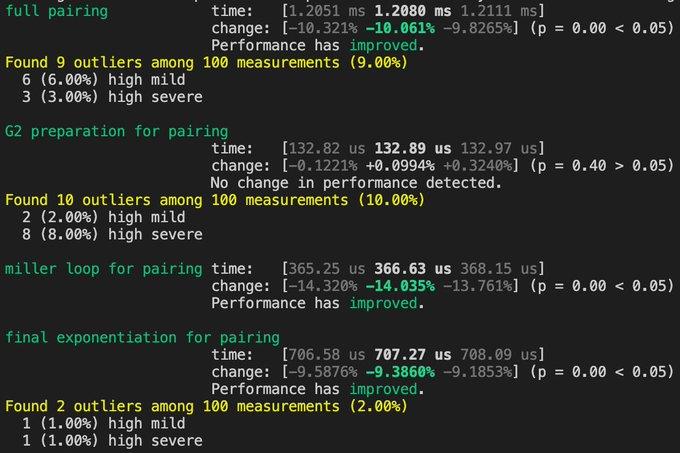
(
a
0
,
a
1
,
⋯
,
a
t
−
1
)
,
(
b
0
,
b
1
,
⋯
,
b
t
−
2
)
(a_0,a_1,\\cdots, a_t-1),(b_0,b_1,\\cdots, b_t-2)
(a0,a1,⋯,at−1),(b0,b1,⋯,bt−2)这2个集合内所有元素均属于特定域
F
p
\\mathbbF_p
Fp of large prime characteristic
p
p
p,所谓sum of products是指类似如下的计算:
c
=
∑
i
=
0
t
−
1
±
a
i
⋅
b
i
m
o
d
p
c=\\sum_i=0^t-1\\pm a_i\\cdot b_i\\mod p
c=∑i=0t−1±ai⋅bimodp
该操作是很多密码学计算的核心,最有名的可能就是multiplication over extension fields with large prime characteristic。
同时,若
a
,
b
∈
F
q
k
a,b\\in \\mathbbF_q^k
a,b∈Fqk,需计算
a
⋅
b
m
o
d
f
a\\cdot b \\mod f
a⋅bmodf,其中
f
=
x
k
−
w
f=x^k-w
f=xk−w,其中
w
w
w为a primitive element in
F
p
∗
\\mathbbF^*_p
Fp∗且
k
∣
(
p
−
1
)
k|(p-1)
k∣(p−1)。则相应的多项式乘积为:

一种广泛的优化实践是使用“accumulation and reduction”策略来优化计算每个
c
j
c_j
cj,该策略也称为lazy reduction——可将modular reduction的数量建委1次(或k次,对于整个多项式乘积来说)。在很多使用场景中,假设
w
w
w具有small coefficients,使得乘积相对便宜。
但是,lazy reduction的主要缺陷在于,需要额外的存储并计算double precision的中间结果。
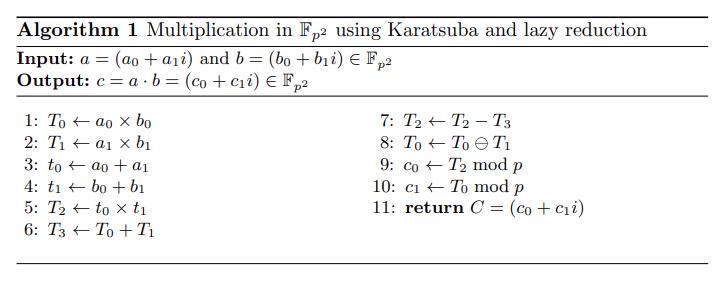
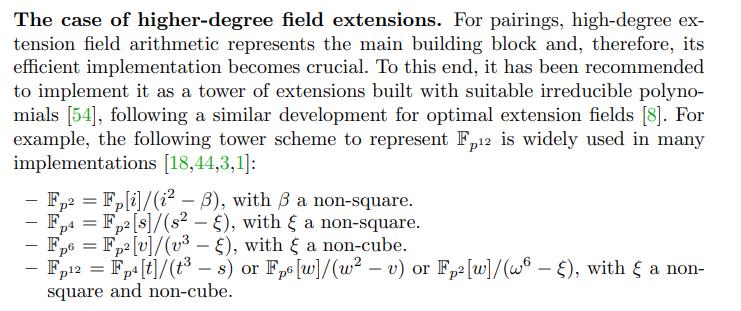
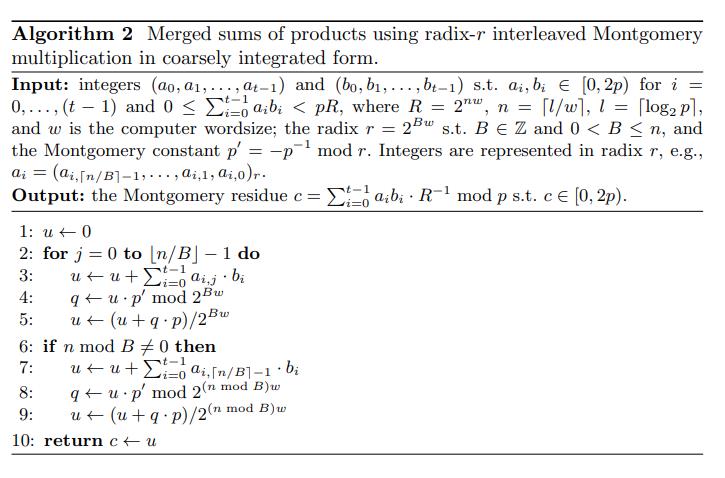
https://github.com/zkcrypto/bls12_381/tree/efficient-extension-field-arithmetic中针对BL12_381的multiplication over
F
p
\\mathbbF_p
Fp为:
/// Returns `c = a.zip(b).fold(0, |acc, (a_i, b_i)| acc + a_i * b_i)`.
///
/// Implements Algorithm 2 from Patrick Longa's
/// [ePrint 2022-367](https://eprint.iacr.org/2022/367) §3.
#[inline]
pub(crate) fn sum_of_products<const T: usize>(a: [Fp; T], b: [Fp; T]) -> Fp
// For a single `a x b` multiplication, operand scanning (schoolbook) takes each
// limb of `a` in turn, and multiplies it by all of the limbs of `b` to compute
// the result as a double-width intermediate representation, which is then fully
// reduced at the end. Here however we have pairs of multiplications (a_i, b_i),
// the results of which are summed.
//
// The intuition for this algorithm is two-fold:
// - We can interleave the operand scanning for each pair, by processing the jth
// limb of each `a_i` together. As these have the same offset within the overall
// operand scanning flow, their results can be summed directly.
// - We can interleave the multiplication and reduction steps, resulting in a
// single bitshift by the limb size after each iteration. This means we only
// need to store a single extra limb overall, instead of keeping around all the
// intermediate results and eventually having twice as many limbs.
// Algorithm 2, line 2
let (u0, u1, u2, u3, u4, u5) =
(0..6).fold((0, 0, 0, 0, 0, 0), |(u0, u1, u2, u3, u4, u5), j|
// Algorithm 2, line 3
// For each pair in the overall sum of products:
let (t0, t1, t2, t3, t4, t5, t6) = (0..T).fold(
(u0, u1, u2, u3, u4, u5, 0),
|(t0, t1, t2, t3, t4, t5, t6), i|
// Compute digit_j x row and accumulate into `u`.
let (t0, carry) = mac(t0, a[i].0[j], b[i].0[0], 0);
let (t1, carry) = mac(t1, a[i].0[j], b[i].0[1], carry);
let (t2, carry) = mac(t2, a[i].0[j], b[i].0[2], carry);
let (t3, carry) = mac(t3, a[i].0[j], b[i].0[3], carry);
let (t4, carry) = mac(t4, a[i].0[j], b[i].0[4], carry);
let (t5, carry) = mac(t5, a[i].0[j], b[i].0[5], carry);
let (t6, _) = adc(t6, 0, carry);
(t0, t1, t2, t3, t4, t5, t6)
,
);
// Algorithm 2, lines 4-5
// This is a single step of the usual Montgomery reduction process.
let k = t0.wrapping_mul(INV);
let (_, carry) = mac(t0, k, MODULUS[0], 0);
let (r1, carry) = mac(t1, k, MODULUS[1], carry);
let (r2, carry) = mac(t2, k, MODULUS[2], carry);
let (r3, carry) = mac(t3, k, MODULUS[3], carry);
let (r4, carry) = mac(t4, k, MODULUS[4], carry);
let (r5, carry) = mac(t5, k, MODULUS[5], carry);
let (r6, _) = adc(t6, 0, carry);
(r1, r2, r3, r4, r5, r6)
);
// Because we represent F_p elements in non-redundant form, we need a final
// conditional subtraction to ensure the output is in range.
(&Fp([u0, u1, u2, u3, u4, u5])).subtract_p()

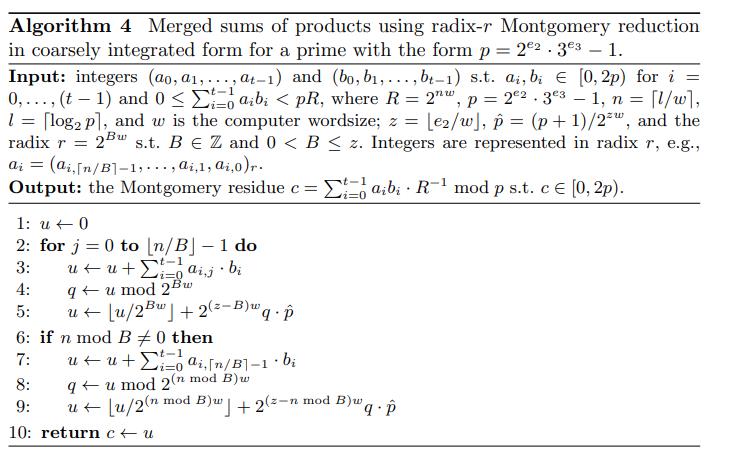
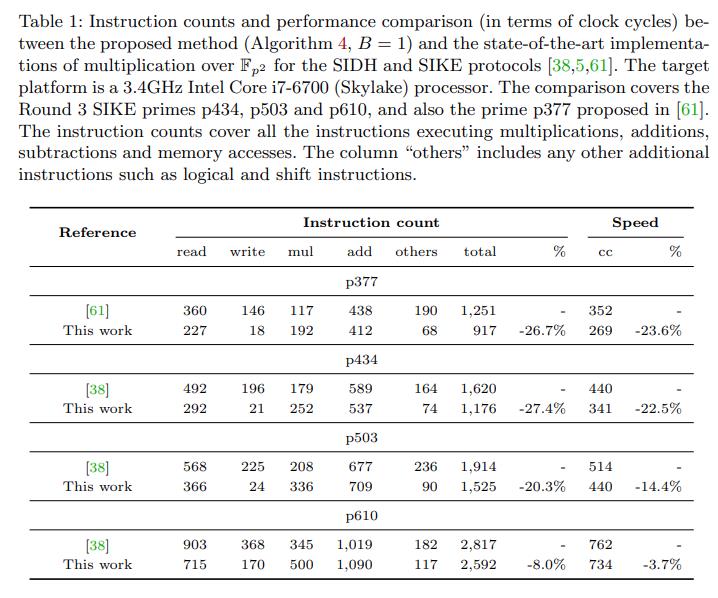
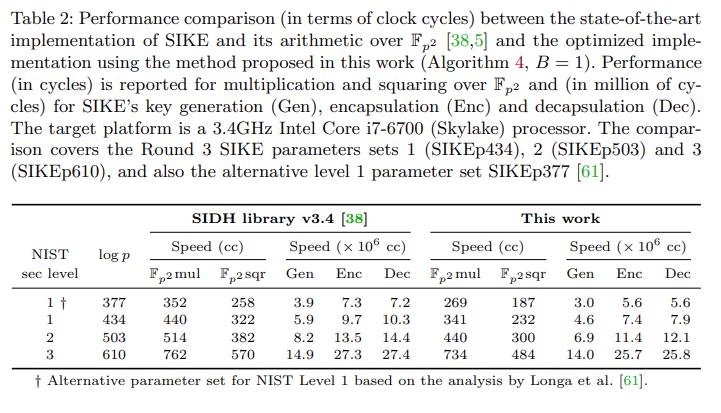

https://github.com/zkcrypto/bls12_381/tree/efficient-extension-field-arithmetic中针对BL12_381的multiplication over
F
p
2
\\mathbbF_p^2
Fp2为:
pub fn mul(&self, rhs: &Fp2) -> Fp2
// F_p^2 x F_p^2 multiplication implemented with operand scanning (schoolbook)
// computes the result as:
//
// a·b = (a_0 b_0 + a_1 b_1 β) + (a_0 b_1 + a_1 b_0)i
//
// In BLS12-381's F_p^2, our β is -1, so the resulting F_p^2 element is:
//
// c_0 = a_0 b_0 - a_1 b_1
// c_1 = a_0 b_1 + a_1 b_0
//
// Each of these is a "sum of products", which we can compute efficiently.
Fp2
c0: Fp::sum_of_products([self.c0, -self.c1], [rhs.c0, rhs.c1]),
c1: Fp::sum_of_products([self.c0, self.c1], [rhs.c1, rhs.c0]),

https://github.com/zkcrypto/bls12_381/tree/efficient-extension-field-arithmetic中针对BL12_381的multiplication over
F
p
6
\\mathbbF_p^6
Fp6为:
impl<'a, 'b> Mul<&'b Fp6> for &'a Fp6
type Output = Fp6;
#[inline]
fn mul(self, other: &'b Fp6) -> Self::Output
self.mul_interleaved(other)
/// Returns `c = self * b`.
///
/// Implements the full-tower interleaving strategy from
/// [ePrint 2022-376](https://eprint.iacr.org/2022/367).
#[inline]
fn mul_interleaved(&self, b: &Self) -> Self
// The intuition for this algorithm is that we can look at F_p^6 as a direct
// extension of F_p^2, and express the overall operations down to the base field
// F_p instead of only over F_p^2. This enables us to interleave multiplications
// and reductions, ensuring that we don't require double-width intermediate
// representations (with around twice as many limbs as F_p elements).
// We want to express the multiplication c = a x b, where a = (a_0, a_1, a_2) is
// an element of F_p^6, and a_i = (a_i,0, a_i,1) is an element of F_p^2. The fully
// expanded multiplication is given by (2022-376 §5):
//
// c_0,0 = a_0,0 b_0,0 - a_0,1 b_0,1 + a_1,0 b_2,0 - a_1,1 b_2,1 + a_2,0 b_1,0 - a_2,1 b_1,1
// - a_1,0 b_2,1 - a_1,1 b_2,0 - a_2,0 b_1,1 - a_2,1 b_1,0.
// = a_0,0 b_0,0 - a_0,1 b_0,1 + a_1,0 (b_2,0 - b_2,1) - a_1,1 (b_2,0 + b_2,1)
// + a_2,0 (b_1,0 - b_1,1) - a_2,1 (b_1,0 + b_1,1).
//
// c_0,1 = a_0,0 b_0,1 + a_0,1 b_0,0 + a_1,0 b_2,1 + a_以上是关于适于Large Prime Characteristic Fields的高效算法及其在Bilinear Pairing和Supersingular Isogeny-Based协议中的应用的主要内容,如果未能解决你的问题,请参考以下文章